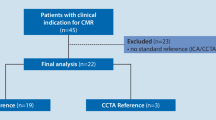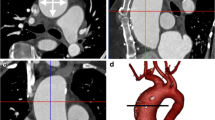Abstract
Purpose
To investigate the relative role of high resolution (spatial or temporal) magnetic resonance angiography (MRA) sequence and of contrast agent properties in the evaluation of high-degree arterial stenosis.
Methods
We qualitatively and quantitatively studied both 50 and 95% (300 μm diameter) stenosis of a 6 mm arterial phantom with two contrast agents (CA), Gd-DOTA (r1 =2.9 mM−1 s−1) versus P760 (r1 =25 mM−1 s−1) at several CA concentrations, including arterial peak concentration after injection of either a single or double dose of CA, using either a high temporal (booster) or high spatial (HR) resolution 3D MRA sequences. Experimental data were then compared to theoretical data.
Results
With the 3D HR sequence, both visual and quantitative analysis were significantly better compared to the 3D booster sequence, at each phantom diameter. Quantitative analysis was significantly improved by injection of a double versus a single dose of each CA (Gd-DOTA or P760), primarily in high degree stenosis.
Conclusion
Combined MRA spatial resolution and high CA efficiency are mandatory to correctly evaluate high degree stenosis.
Similar content being viewed by others
References
Maki JH, Chenevert TL. Prince MR. Three-dimensional contrast-enhanced MR angiography. Top Magn Reson Imaging 1996;8(6):322–44.
Prince MR, Narasimham DL. Jacoby VVT, et al. Three-dimensional gadolinium-enhanced MR angiography of thoracic aorta. Am J Radiol. 1996; 166;1387–97.
Leung DA, Debatin JF, et al. Three-dimensional contrast-enhanced magnetic resonance angiography of thoracic vasculature. Eur Radiol 1997;7:981–9.
Prince MR, Narasimham DL, Stanley JC, et al. Breath-hold gadolinium-enhanced MR Angiography of the abdominal aorta and its major branches. Radiology 1995;197:785–92.
Prince MR, Yucel EK, Kaufman JA, Harrison DC, Geller SC. Dynamic gadolinium-enhanced three-dimensional abdominal MR arteriography. J Magn Reson Imaging 1993;3:877–81.
Nasim A. Thompson MM. Savers RD. et al. Role of magnetic resonance angiography for assessment of abdominal aortic aneurysm before endoluminal repair. Br J Surg 1998;85(5):641–4.
Patel MR, Kuntz KM, Klufas RA, et al. Preoperative assessment of the carotid bifurcation. Can magnetic resonance angiography and duplex ultrasonography replace contrast arteriography. Stroke 1995;26(10):1753–8.
Kim JK, Farb I, Wright GA. Test bolus examination in the carotid artery at dynamic gadolinium-enhanced MR angiography. Radiology 1998;206(l):283–9.
Levy RA, Maki JH. Three-dimensional gadolinium-enhanced MR angiography of the extracranial atherosclerotic carotid arteries: two techniques. Am J NeuroRadiol 1998;4:688–90.
Hany TF, Debatin JF, Leung DA, et al. Evaluation of the aortoiliac and renal arteries: comparison of breath hold, contrast-enhanced, three-dimensional MR angiography with conventional catheter angiography. Radiology 1997;204:357–62.
Bass JC, Prince MR. Londy FJ, Chenevert TL. Effect of gadolinium on phase-contrast MR angiography of the renal arteries. Am J Radiol 1997;1:261–6.
Schoenberg SO, Bock M, Knopp MV, et al. Renal arteries: optimization of three-dimensional gadolinium-enhanced MR angiography with bolus-timing-independent fast multiphase acquisition in a single breath-hold. Radiology 1999;211(3):667–79.
Douek PC, Revel D, Chazel S, Falise B, Villard J, Amiel M. Fast MR angiography of the aortoiliac arteries and arteries of the lower extremity: value of bolus-enhanced, whole-volume substraction technique? Am J Radiol 1995;165:431–7.
Poon E, Yucel EK, Pagan-Marin H, Kayne H. Iliac artery stenosis measurements: comparison of two-dimensional time-of-flight and three-dimensional dynamic gadolinium-enhanced MR angiography. Am J Radiol 1997;169(4):1139–44.
Visser K, Hunink M. Peripheral arterial disease: gadolinium-enhanced MR angiography versus color-guided duplex US. A meta-analysis. Radiology 2000;216:67–77.
Lorenz CH., Johansson LOM. Review: contrast-enhanced coronary MRA. J Magn Reson Imaging 1999;10:703–8.
Goldfarb JW, Edelman RR. Coronary arteries: breath hold, gadolinium-enhanced, three-dimensional MR angiography. Radiology 1998;206:830–4.
Marchand B, Douek PC. Benderbous S, Corot C, Canet E. Pilot MR evaluation of pharmacokinetics and relaxivity of specific blood pool agents for MR angiography. Invest Radiol 2000;35(l):41–9.
Corot C, Port M, Raynal I. et al. Physical, chemical, and biological evaluations of P760: a new gadolinium complex characterized by a low rate of interstitial diffusion. J Magn Radiol Imaging 2000;11:182–91.
Corot C, Violas X. Robert P, Port M. Pharmacokinetics of three gadolinium chelates with different molecular sizes shortly after intravenous injection in rabbits. Relevance to MR angiography. Invest Radiol 2000;35(4):213–8.
Port M. Meyer D, Bonnemain B, et al. P760 and P 775: MRI contrast agents characterized by new pharmacokinetic properties. MAGMA 1999;8:172–6.
Renaudin CD, Barbier B. Roriz R, Revel D., Amiel M. Coronary arteries: new design for three-dimensional arterial phantoms. Radiology 1994;190:579–82.
Gros DR, editor. Animal, Models in Cardiovascular Research. 2nd edition. Dordrecht: Kluwer Academic Publishers; 1994;153:373.
Marchand B, Hernandez-Hoyos M, Orkisz M, Canet E, Douek P. Diagnosis of renal artery stenosis with magnetic resonance angiography and stenosis quantification. J Mal Vasc 2000;25:312–20.
Cremillieux Y, Briguet A, Deguin A. Projection-reconstruction methods: fast imaging sequences and data processing. Magn Reson Med 1994;32:23–32.
Zur Y, Stokar S, Bendel P. An analysis of fast imaging sequences with steady-state transverse magnetization refocusing. Magn Reson Med 1988;6:175–93.
Maki JH, Prince MR, Chenevert TC. Optimizing three-dimensional gadolinium-enhanced magnetic resonance angiography. Original investigation. Invest Radiol 1998;33(9):528–37.
Westcnberg JJM, Wasser MN, van Der Geest RJ, et al. Scan optimization of gadolinium contrast-enhanced three-dimensional MRA of peripheral arteries with multiple bolus injections and in vitro validation of stenosis quantification. Mugn Reson Imaging 1999; 17(1):47–54.
Bourne MW, Margerun L, Hylton N, et al. Evaluation of the effects of intravascular MR contrast media (Gadolinium Dendrimer) on 3D time of flight magnetic resonance angiography of the body. J Magn Reson Imaging 1996;6:305–10.
Loubeyre P, Canet E, Zhao S, Benderbous S, Amiel M, Revel D. Carboxymethyl-dextran-gadolinium-DTPA as a blood pool contrast agent for magnetic resonance angiography. Invest Radiol 1996;31:288–93.
Moseley ME, White DL, Wang JO et al. Vascular mapping using albumin-(Gd-DTPA), an intravascular MR contrast agent, and projection MR imaging. J Comput Assisst Tomogr 1989; 13:215–21.
Schumann-Giampieri G, Schmitt-Willich H, Frenzel T, et al. In vivo and in vitro -evaluation of Gd-DTPA-polylysine as a macromolecular contrast agent for magnetic resonance imaging. Invest Radiol 1991;26:969–74.
Loubeyre P, Zhao S, Canet E, Abidi H, Benderbouss S, Revel D. Ultrasmall superparamagnetic iron o.xyde particles (AMI 227) as a blood pool contrast agent for MR angiography: experimental study in rabbits. J Magn Radiol Imaging 1997;7:958–62.
Tanimoto A. Yuasa Y, Hiramatsu K. Enhancement of phase-contrast MR angiography with superparamagnetic iron oxide. J Magn Radiol Imaging 1998;8:446–50.
Cavagna FM, Maggioni F, Castelli PM, et al. Gadolinium chelates with weak binding to serum proteins. A new class of high-efficiency, general purpose contrast agents for magnetic resonance imaging. Invest Radiol 1997;32:780–96.
Spinazzi A. Lorusso V, Pirovano G, kirchin MA. Safety, tolerance, biodistribution and MR imaging enhancement of the liver with Gd-BOPTA: results of clinical pharmacologic and pilot imaging studies in non-patient and patient volunteers. Acta Radiol 1999;6:282–91.
Zheng J, Finn P, Carr J, et al. 3D pulmonary perfusion and angiography with a new intravascular contrast agent BR22956/1 in detection of pulmonary flow and perfusion defects. In: Proceedings of the 8th Annual Scientific meeting of the Society of Magnetic Resonance in Medicine. Denvers, Color: Society of Magnetic Resonance in Medicine, 2000:526.
Lauffer RB, Parmelee DJ, Ouellet HS, et al. MS-325:a small-molecule vascular imaging agent for magnetic resonance imaging. Acad Radiol 1996;3:S356–8.
Lauffer RB, Parmelee DJ, Dunham SU, et al. MS-325: Albumintargeted contrast agent for MR angiography. Radiology 1998;207:529–38.
Kroft LJ, Doornbos J, van der Geest RJ, Benderbous S, de Roos A. Infarcted myocardium in pigs: MR imaging enhanced with slow-interstitial-diffusion gadolinium compound P 760. Radiology 1999;212(2):467–73.
Dong Q, Hurst DR, Weinmann HJ, Chenevert TL, Londy FJ, Prince MR. Magnetic resonance angiography with Gadomer-17. An animal study original investigation. Invest Radiol 1998;33(9):699–708.
Clarke SE, Weinmann H-J, Dai H, Lucas AR, Rutt BK. Comparison of two blood pool contrast agent for 0.5 T MR angiography: experimental study in rabbits. Radiology 2000;14:787–94.
Rose A. Vision: human and electronic. In: Optical Physics and Engineering. New York: Plenum, 1973.
Watts R, Wang Y, Winchester PA, Khilnani N. Yu L. Rose Model in MRI: noise limitations on spatial resolution and implications for contrast enhanced MR angiography. In: Proceedings of the 19th Annual Scientific meeting of the Society of Magnetic Resonance in Medicine. Denvers, Color: Society of Magnetic Resonance in Medicine, 2000:462.
Boos M. Lentschig M, Scheffler K, Bongartz GM., Steinbrich W. Contrast enhanced magnetic resonance angiography of peripheral vessels. Different contrast agent applications and sequence strategies: a review. Invest Radiol 1998;33:538–46.
Lentschig MG, Reimer P, Rausch-Lentschig UL, Allkemper T, Oelerich M., Laub G. Breath-hold gadolinium-enhanced MR angiography of the major vessels at 1.0 T: dose-response findings and angiographic correlation. Radiology 1998;208:235–357.
Author information
Authors and Affiliations
Corresponding author
Rights and permissions
About this article
Cite this article
Marchand, B., Douek, P.C., Robert, P. et al. Standardized MR protocol for the evaluation of MRA sequences and/or contrast agents effects in high-degree arterial stenosis analysis. MAGMA 14, 259–267 (2002). https://doi.org/10.1007/BF02668220
Received:
Revised:
Accepted:
Issue Date:
DOI: https://doi.org/10.1007/BF02668220




